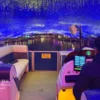Navigating Beijing’s public transport system can seem daunting for foreign tourists. However, with some preparation, you can travel around the city efficiently and affordably. Beijing offers a comprehensive public transport system that includes buses, subways, and taxis.
This guide will help you understand how to use Beijing’s public transport, providing tips and essential information to make your journey smooth and enjoyable.
Getting Started: Essential Preparations
1. Transportation Cards
First, get a Beijing Pass for foreign travelers ( a kind of Transportation Smart Card) , locally also known as the Yikatong card. You can buy this card at Beijing Airports and any subway stations. The card costs 20 RMB as a refundable deposit, and you can load it with additional funds. Using the Beijing Pass (Yikatong card) offers discounted fares on subways and buses and makes the payment process seamless.
2. Downloading Useful Apps
Next, download useful apps like Baidu Maps, DiDi (for taxis), and Beijing Subway Guide. These apps provide real-time information on routes, schedules, and transit options. They also offer English language support, which is helpful for non-Chinese speakers.
Using the Beijing Subway
1. Understanding the Subway System
The Beijing Subway is the fastest way to travel around the city. It consists of 24 lines, covering most major attractions and districts. Each line is color-coded and numbered, making it easy to identify routes. Subway stations have signs and maps in both Chinese and English.
2. Buying Tickets
You can buy tickets at vending machines or ticket counters in subway stations. If you have a Yikatong card, simply tap it at the entry gate. Vending machines accept cash and sometimes major credit cards. Select your destination, pay the fare, and receive a paper ticket or a token.
3. Navigating the Subway
After entering the station, follow the signs to your specific line. Platforms are clearly marked, and trains arrive every few minutes. Pay attention to the last train times, as they vary between lines. Missing the last train can leave you stranded, especially late at night. Inside the train, listen for English announcements and check the digital displays for station information.
Using Beijing Buses
1. Understanding the Bus System
Buses complement the subway system by reaching areas not accessible by train. However, the bus network can be confusing for first-time users due to fewer English signs. It’s best to use Baidu Maps for real-time bus information and routes.
2. Paying for Bus Rides
When boarding a bus, you can use your Yikatong card or pay in cash. Fares vary based on distance, but using the Yikatong card offers discounts. Make sure you have small change if paying in cash, as drivers do not provide change.
3. Bus Etiquette and Tips
Always enter the bus through the front door and exit through the rear door. Give up your seat to the elderly, disabled, and pregnant women. Keep an eye on your belongings, as buses can get crowded during peak hours. Also, press the stop button a stop ahead of your destination to alert the driver.
Using Beijing Taxis
1. Finding and Hailing a Taxi
Taxis are plentiful in Beijing and can be hailed on the street or booked via the DiDi app. Using the app is often easier, as it provides the driver’s details and fare estimate. Ensure the taxi has a functioning meter to avoid overcharging.
2. Taxi Fares and Payment
Taxi fares start at around 13 RMB for the first 3 kilometers, with additional charges per kilometer and for waiting time. You can pay in cash or use mobile payment apps like Alipay and WeChat Pay. Keep small bills handy for taxi rides. Check out: Beijing Taxi Guide
3. Communicating with Drivers
Most taxi drivers do not speak English. Therefore, have your destination written in Chinese or show it on a map. The DiDi app also offers translation features to help communicate with the driver.
Using Beijing’s Bicycle Sharing Programs
1. Introduction to Bike Sharing
Beijing has several bike-sharing programs, such as Mobike and Ofo. These services allow you to rent bicycles for short trips, offering a convenient and eco-friendly way to explore the city.
2. Registering and Renting Bikes
Download the relevant app and register with your phone number. You may need to link a payment method, like a credit card or mobile payment app. Use the app to find and unlock a nearby bike by scanning its QR code. Rides are typically charged by the hour.
3. Riding Tips and Rules
Stick to bike lanes and avoid riding on busy roads. Wear a helmet if possible, and always follow traffic rules. Return the bike to a designated parking area when finished, ensuring it is locked properly.
Safety Tips for Using Public Transport
1. Stay Vigilant
Keep an eye on your belongings, especially in crowded areas like subways and buses. Pickpocketing can occur, so be mindful of your wallet, phone, and other valuables.
2. Avoid Peak Hours
If possible, avoid using public transport during rush hours (7-9 AM and 5-7 PM). Trains and buses can be extremely crowded, making travel uncomfortable and potentially unsafe.
3. Carry Identification
Always carry a form of identification, such as a photocopy of your passport. This is useful in case of any emergencies or if authorities request it during random checks.
Exploring Beyond Beijing
1. Taking Trains
Beijing is well-connected to other major cities by high-speed trains. The Beijing South Railway Station and Beijing West Railway Station serve as main hubs. Book tickets in advance, either online or at the station, and arrive early for security checks.
2. Long-Distance Buses
For travel to nearby provinces, long-distance buses are a viable option. The Beijing Bus Terminal offers services to various destinations. Ensure you buy tickets from official counters to avoid scams.
Using Beijing’s public transport system can be straightforward and efficient with a bit of preparation. Whether you prefer the speed of the subway, the reach of buses, the convenience of taxis, or the freedom of bike-sharing, this guide provides all the information you need. With a Yikatong card in hand and useful apps downloaded, you can confidently explore the city’s many attractions. Remember to stay vigilant, avoid peak hours, and carry identification to ensure a safe and enjoyable journey. Happy travels!
More Beijing Travel Guides
Planning your Beijing tour? Our “Beijing Travel Guide“ section offers essential advice to help you navigate the city like a pro. From transportation tips and local customs to insider recommendations for hidden gems, these travel tips will ensure you have a smooth, enjoyable, and unforgettable experience in China’s vibrant capital. Let us guide you through the best practices for exploring Beijing with confidence!



